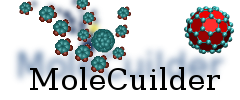| 1 | /*
|
|---|
| 2 | * Project: MoleCuilder
|
|---|
| 3 | * Description: creates and alters molecular systems
|
|---|
| 4 | * Copyright (C) 2010 University of Bonn. All rights reserved.
|
|---|
| 5 | * Please see the LICENSE file or "Copyright notice" in builder.cpp for details.
|
|---|
| 6 | */
|
|---|
| 7 |
|
|---|
| 8 | /**
|
|---|
| 9 | * \file mainpage.dox
|
|---|
| 10 | *
|
|---|
| 11 | * Here, the mainpage (index.html) for the doxygen documentation resides.
|
|---|
| 12 | *
|
|---|
| 13 | * Created on: Oct 11, 2011
|
|---|
| 14 | * Author: heber
|
|---|
| 15 | */
|
|---|
| 16 |
|
|---|
| 17 | /*! \page copyright Copyright notice
|
|---|
| 18 | *
|
|---|
| 19 | * MoleCuilder - to create and alter molecular systems
|
|---|
| 20 | * Copyright (C) 2010 University Bonn. All rights reserved.
|
|---|
| 21 | *
|
|---|
| 22 | */
|
|---|
| 23 |
|
|---|
| 24 | /** \mainpage MoleCuilder - a molecular set builder
|
|---|
| 25 | *
|
|---|
| 26 | * This is the main page of the Doxygen documentation of \e MoleCuilder. We give
|
|---|
| 27 | * a brief description what the program is intended to do and then branch via
|
|---|
| 28 | * the contents of this documentation into various topics.
|
|---|
| 29 | *
|
|---|
| 30 | * \section about About the Program
|
|---|
| 31 | *
|
|---|
| 32 | * MoleCuilder is a program, written entirely in C++, that enables the
|
|---|
| 33 | * construction of a coordinate set for the atoms making up a molecular system. It
|
|---|
| 34 | * allows for both building of simple molecules by adding atom-wise giving bond
|
|---|
| 35 | * angles and distances or absolute coordinates, but also using them as
|
|---|
| 36 | * templates. Regions can be specified and ordered to be filled with a molecule
|
|---|
| 37 | * in a certain manner. Greater conglomerations of molecules can be tesselated
|
|---|
| 38 | * and recognized as a region themselves to be subsequently surrounded by other
|
|---|
| 39 | * (surface solvated) molecules.
|
|---|
| 40 | * Once initial configurations have been created, empirical potential functions
|
|---|
| 41 | * can be fitted to ab-initio calculations -- calculated quickly via the BOSSANOVA
|
|---|
| 42 | * scheme -- to enable subsequent (classical) molecular dynamics simulations.
|
|---|
| 43 | *
|
|---|
| 44 | * For copyright see \ref copyright.
|
|---|
| 45 | *
|
|---|
| 46 | * \section idea The central idea behind the program
|
|---|
| 47 | *
|
|---|
| 48 | * What are the central ideas?
|
|---|
| 49 | *
|
|---|
| 50 | * - Testedness: See \ref tests-policy which is meant \e seriously. Nothing is
|
|---|
| 51 | * worse than one version behaving different to the next with respect to
|
|---|
| 52 | * output.
|
|---|
| 53 | * - Re-usability: Every piece of functionality should be easy to re-use at
|
|---|
| 54 | * someplace else. Say no to specialized one-purpose scripts, say yes to
|
|---|
| 55 | * a LEGO-like system of building your world.
|
|---|
| 56 | * - Extendability: It's easy to add a new piece to the code. And it is even
|
|---|
| 57 | * more so, if you have read this documentation and know what's all already
|
|---|
| 58 | * in place.
|
|---|
| 59 | * - Userfriendliness: Every Action can be undone, every Action gives lots
|
|---|
| 60 | * of output (if desired) to tell you what's going on. It's easy to save
|
|---|
| 61 | * files in between. There are also three kinds of GUIs, each of which
|
|---|
| 62 | * have the same functionality.
|
|---|
| 63 | * - Scriptability: Eventually, you want to create lots of configurations with
|
|---|
| 64 | * only small differences. A session can be stored as either command-line or
|
|---|
| 65 | * python script and extended to create all of the configurations in a straight-
|
|---|
| 66 | * forward manner.
|
|---|
| 67 | *
|
|---|
| 68 | * \section contents Contents
|
|---|
| 69 | *
|
|---|
| 70 | * This manual is divided into the following sections:
|
|---|
| 71 | * \li \ref install
|
|---|
| 72 | * \li \ref tests
|
|---|
| 73 | * \li \ref launch
|
|---|
| 74 | * \li \ref data
|
|---|
| 75 | * \li \ref debug
|
|---|
| 76 | * \li \ref code
|
|---|
| 77 | * \li \ref fileformats
|
|---|
| 78 | *
|
|---|
| 79 | * \date 2014-03-10
|
|---|
| 80 | *
|
|---|
| 81 | */
|
|---|
| 82 |
|
|---|
| 83 |
|
|---|
| 84 |
|
|---|
